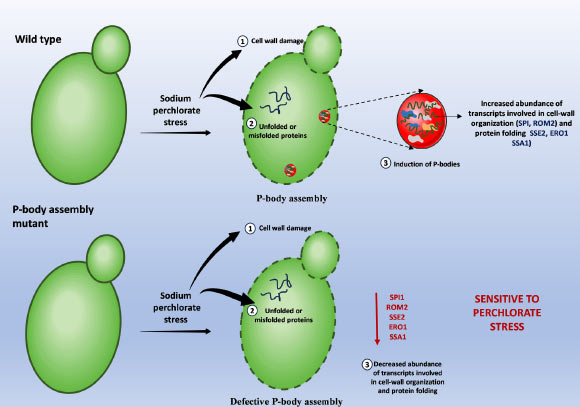Exploring the possibility of the survival of life under extraterrestrial conditions is an important goal of astrobiology. In a new study, scientists used baker’s yeast, a powerful model organism, to assess the impact of Mars-like conditions; they observed that yeast survive shock waves and perchlorate treatment — two stressors relevant to Mars; further, yeast responds to Martian conditions by assembling conserved RNA-protein complexes.

Model depicting the importance of RNP condensate in mediating survival under Mars-like stress condition. Image credit: Dhage et al., doi: 10.1093/pnasnexus/pgaf300.
“With advances in space science and astrobiology, exploring the potential of Mars in supporting life forms is gaining significant attention,” said Indian Institute of Science’s Dr. Purusharth Rajyaguru and colleagues.
“Mars offers a range of hostile environmental conditions that a potential life form would need to overcome.”
“Thus, understanding its unique and challenging environmental conditions becomes important.”
“Martian stress conditions are characterized by the following: (i) high-intensity shock waves resulting from meteorite impacts, (ii) extreme temperature and pressure fluctuations, (iii) ionizing and solar UV radiations due to a thin atmosphere, and (iv) chaotropic agents like perchlorates.”
“These conditions pose a serious obstacle to the survival of potential life forms.”
In the study, the authors subjected Saccharomyces cerevisiae, which is a widely used model yeast, to shock waves and perchlorates.
They chose the yeast in part because it has already been studied in space.
When stressed, yeast, humans, and many other organisms form ribonucleoprotein (RNP) condensates, structures made of RNA and proteins that protect RNA and affect the fates of mRNAs.
When the stressor passes, the RNP condensates, which include subtypes known as stress granules and P-bodies, disassemble.
Yeast exposed to 5.6 Mach intensity shock waves survived with slowed growth, as did yeast subjected to 100 mM sodium salt of perchlorate (NaClO4) — a concentration similar to that in Martian soils.
Yeast cells also survived exposure to the combined stress of shock waves and perchlorate stress.
According to the team, in both cases, the yeast assembled RNP condensates.
Shock waves induced the assembly of stress granules and P-bodies; perchlorate caused yeast to make P-bodies but not stress granules.
Mutants incapable of assembling RNP condensates were poor at surviving the Martian stress condition.
Transcriptome analysis identified specific RNA transcripts perturbed by Mars-like conditions.
“The results show the importance of yeast and RNP condensates in understanding the effects of Martian conditions on life,” the scientists concluded.
Their paper appears today in the journal PNAS Nexus.
_____
Riya Dhage et al. 2025. Ribonucleoprotein (RNP) condensates modulate survival in response to Mars-like stress conditions. PNAS Nexus 4 (10): pgaf300; doi: 10.1093/pnasnexus/pgaf300







